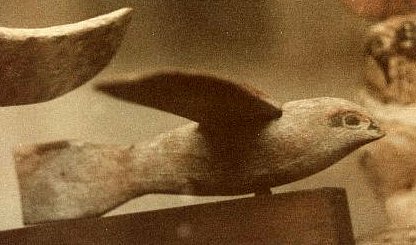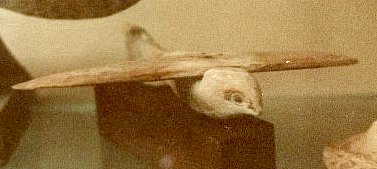An Egyptian Model Airplane
Today, we fly an old, old airplane. The University of Houston's College of Engineering presents this series about the machines that make our civilization run, and the people whose ingenuity created them.
The ancient bird models in the Cairo Museum were all pretty similar. Only one in the set was wrong. It was made of sycamore wood -- a little thing with a 7-inch wingspan. In 1969 Khalil Messiha, an Egyptian doctor and amateur student of bird models, noticed it. It stood out for him because he saw it through the eyes of his childhood. He recalled the shapes and forms he'd worked with when he'd built model airplanes. This wasn't a bird at all. It was a model airplane, and that wasn't possible.
The other birds had legs. This had none. The other birds had painted feathers. This had none. The other birds had horizontal tail feathers like a real bird. Perhaps that was the most important thing. Birds don't have to be stable in flight because they can correct their direction. But a model airplane needs a vertical rudder to keep it moving straight. This strange wooden model tapered into a vertical rudder. One can also see that the wing has an airfoil cross-section. It was all aerodynamically correct. Too much about the model was beyond coincidence. Messiha's brother, a flight engineer, reproduced it in balsa wood and launched it. It flew. It really flew!
The model was dug up in Sakkara a hundred years ago. Sakkara is a site of ancient ruins, but this model is more recent. It's from the 3rd century BC, from an age of invention that followed the death of Alexander the Great. That so-called Hellenistic period gave us gears, screws, plumbing, control valves, Euclidian geometry, Archimedes, and Ptolemy's astronomy.
And so, it seems, it also produced a modern concept of flight. 1800 years later Leonardo da Vinci was still trying to invent flapping-wing airplanes and corkscrew-driven helicopters. But here, an Egyptian had produced something with all the features of a modern sailplane.
Did anyone actually build a large version of this thing? Well, no one could have come this close to the real shape of flight without working on a larger scale. This little wooden model could hardly exist unless someone had worked with large, light models, or even with man-carrying versions.
Archaeologists have looked in vain for a prototype. A large model light enough to fly would be too delicate to stand the ravages of 2300 years. The original -- if it ever was -- has long since joined the desert dust. Whatever form this Egyptian airplane might have taken, it has long since returned to the world of dreams and imagination from which it first came.
I'm John Lienhard, at the University of Houston, where we're interested in the way inventive minds work.
(Theme music)
Blacks in Science: Ancient and Modern (I. van Sertima, ed.). New Brunswick, N.J.: Transaction Books, pp. 92-99.


Thanks to Dawoud Khalil Messiha for these photos of the Cairo Museum "bird"